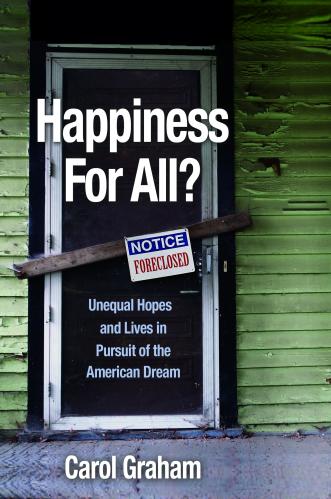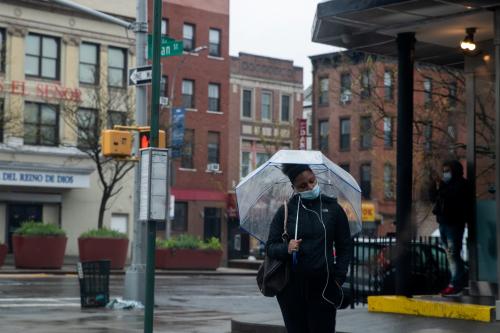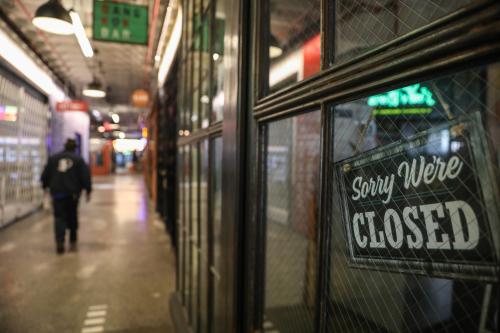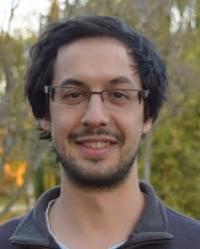The following is an excerpt from Reopening America: How to Save Lives and Livelihoods, a report published May 28, 2020 where Brookings experts offer ideas to help policymakers protect lives and save livelihoods in the midst of the current COVID-19 pandemic.
 COVID-19 is an exponential shock shining a microscope on U.S. society’s deep divisions, the vulnerability of our low-income population, and our woefully inadequate health and social safety net systems. Right now, America leads the world in incidence and deaths, with over 1 million cases and over 90,000 deaths as of May 19. Despite the heroic efforts of first responders, hospitals are overwhelmed in many urban areas, and absent in many rural ones. Essential protective equipment is in short supply, testing rates are far lower than in most other wealthy countries, and inconsistencies in federal guidance and state-level policies leave us vulnerable to a second spike. There were over 20 million unemployment claims in April alone, and estimates of the labor market fallout in the U.S. show the unemployment rate approaching 20 percent.
COVID-19 is an exponential shock shining a microscope on U.S. society’s deep divisions, the vulnerability of our low-income population, and our woefully inadequate health and social safety net systems. Right now, America leads the world in incidence and deaths, with over 1 million cases and over 90,000 deaths as of May 19. Despite the heroic efforts of first responders, hospitals are overwhelmed in many urban areas, and absent in many rural ones. Essential protective equipment is in short supply, testing rates are far lower than in most other wealthy countries, and inconsistencies in federal guidance and state-level policies leave us vulnerable to a second spike. There were over 20 million unemployment claims in April alone, and estimates of the labor market fallout in the U.S. show the unemployment rate approaching 20 percent.
DEATHS OF DESPAIR
Social and economic costs are unevenly shared, with low-income workers more vulnerable to lay-off, to be working a job that exposes them to the virus, and to having inferior access to quality healthcare and health insurance. This falls on top of a pre-existing crisis of deaths of despair (due to alcohol, drugs, or suicide) which have taken over 1 million lives since 1999. While urban deaths have disproportionately fallen on poor minorities— particularly African Americans, in rural areas, where incidence is just beginning to increase, it will likely impact the low-income white population that is most vulnerable to deaths of despair.
Prior to the crisis, a 2017 study estimated that a 1 percent increase in county-level unemployment resulted in a 3 percent increase in drug related deaths. While an employment shock of this magnitude makes it impossible to impose a similar projection, it is hard to imagine any uplifting scenario. Already in March there were reports of increased gun purchases (guns account for the majority of successful suicide attempts) and calls to suicide hot-lines.
While tragic, the pandemic is giving these issues visibility and urgency. How to address them is a challenge that stems well beyond the virus. Trust in our institutions is lower than that of most wealthy countries, and certainly than that of those countries that have successfully managed the crisis in Europe. With public confidence in the U.S. running in the high 30s, we score much lower than New Zealand (70 percent), Finland (66 percent), Norway (60 percent), and Germany (high 50s), slightly below France (high 30s) and Spain (high 30s), and above Italy (21 percent).
One way to frame our efforts to address the crisis and heal our nation is to focus on our society’s well-being rather than solely on the state of our economy.
THE VIRTUES OF HIGH PUBLIC TRUST
Most of the countries with higher public trust have much more coherent social welfare systems 65 than we do, and even so many European countries took decisive action to mitigate the increase in unemployment by directly reimbursing firms for the wage costs to keep their workers on the payroll. In contrast, unlike every other high income country, the U.S. has a health insurance system that is tied to employment, making unemployment a dual income and health shock. Our fragmented safety net system, meanwhile, varies widely across states and stigmatizes the most vulnerable that need support such as food stamps or cash assistance.
Managing a pandemic that requires coordinated social distancing by millions of people cannot succeed without public trust in the government. In addition to low levels of trust, inconsistencies in the information presented by our federal government, contradicting public health officials and scientists, and the deep political divisions reflected in particular states’ response to closing their economies and premature moves to reopen, have likely lowered public confidence even further—and increased the long-run economic and social costs.
FOCUS ON WELL-BEING
One way to frame our efforts to address the crisis and heal our nation is to focus on our society’s well-being rather than solely on the state of our economy. As in the case of public trust, we score much lower than other countries of comparable or even lower levels of income on national average well-being rankings, as assessed by the annual World Happiness Report, coming in at 18th in 2019, down from 11th in 2011. The same data highlights higher levels of trust and stronger social connections in the higher ranked countries.
One reason for our low well-being relative to our income is that we have high levels of inequality in well-being as well as income. There are large gaps in most well-being markers—life satisfaction, hope for the future, and daily enjoyment, and in stress and worry—across the rich and the poor. The latter report significantly lower scores on all these markers. Even reported pain is unequal, with the poor—and particularly the rural poor—reporting more pain than the rich. Respondents in the U.S. report more pain on a daily basis than respondents in 30 other countries, many of which have much lower levels of income.
None of this put us in a good position to manage the coronavirus shock. It hit the most vulnerable disproportionately in job losses and in vulnerability to getting ill due to the kinds of jobs they have or had. And these same people have very limited margin to absorb income shocks and fewer resources to deal with the related mental and physical health spillovers.
A March 2020 Gallup survey of 8,572 respondents in a running nationwide panel (of the same respondents interviewed over the course of two years) highlights the differences in the costs to well-being across the rich and the poor. Low-income respondents (with incomes below $36,000) reported more negative emotions than did high income respondents (with incomes above $90,000). Sixty-four percent of low-income respondents reported worry the day before compared to 60 percent of high-income ones; many of the other differences across the two groups were larger, including sadness (45 percent versus 28 percent), loneliness (48 percent versus 18 percent), and anger (28 versus 23 percent). The one exception was stress: 62 versus 64 percent.
These represent significant increases in negative emotions relative to earlier years. Our comparisons are imperfect, given that they are based on similar but not the same samples: the Gallup panel for March 2020 versus the 2017 daily Gallup Healthways poll (which displays similar trends in well-being for the previous few years). Yet they are for the same income groups. The differences are stark. The average in 2017 for reported stress for the low-income respondents was 47 percent compared to 38 percent for high income ones, and reported worry was 41 percent of the former compared to 28 percent for the latter. There is a clear increase in March 2020 for both groups (64 percent worry for low-income groups versus 41 percent in 2017). The indicators increased more for the rich than for the poor—not surprising as they started at a much lower level—but an income gradient remains.
THE CLASS DIVIDE
Based on that same panel survey, Jonathan Rothwell—of Gallup and Brookings—highlights the different abilities of the poor and the rich to work at home and practice social distancing. He also finds a remarkably deep ideological divide in concerns about the virus. While 59 percent of those in the bottom income quintile report to practice social distancing, 71 percent of those in the top quintile do. And 71 percent of those in the top quintile can work from home, but only 41 and 35 percent of the bottom and second quintile respectively can, an inequity that is exacerbated by differential access to broadband internet.
There are also deep inequities in health and in the pre-existing conditions that are associated with higher levels of COVID-19 mortality. Incidences of diabetes and chronic obstructive pulmonary disease are 22 percent and 11 percent respectively for those in the bottom quintile versus an average of 7 percent and 2 percent for those in the top quintile. These vulnerabilities created a perfect storm for the havoc that COVID-19 wreaked on the livelihoods—and health—of this population, and that rapidly overwhelmed our frayed and inadequate safety nets.
PARTY DIVISIONS
Views about the dangers of COVID-19—and associated behaviors—are remarkably different across Democrats and Republicans. Rothwell finds that 52 percent of Democrats versus 37 percent of Republicans say they have practiced social distancing and avoided small gatherings. And the differences in state policies surrounding lockdowns and reopening often reflect this political divide. The same divide appears across races. The New York Times notes that of the lockdown opposers, only 5 percent are minority workers who have lost their jobs, while 70 percent are white workers who have not lost their jobs.
While it is difficult to find anything other than tragedy in this pandemic, perhaps its extremity will force a public conversation about the divisions in our society. Well-being can serve as an organizing frame that does not come with political or ideological undertones and that provides robust metrics to measure the aspects of our lives that are essential to health and welfare but are often left out of our standard economic indicators. As we have written earlier, the metrics allow us to attach relative weights to health (mental and physical), meaningful work, learning and creativity, insecurity, and social connections, among other things, and to compare them in equivalent income terms. These measures may be helpful in beginning a new conversation about how to restore our social coherence and well-being.
In the short-term, they can serve as useful tools to inform current discussions about the appropriate time to reopen economies. Paul Dolan of the London School of Economics calculated the monetary value of a prevented fatality for the “average” person and compared it to the monetary equivalent of the well-being losses associated with unemployment, loneliness, domestic violence and child abuse, and suicide and other mental health problems exacerbated by lockdown. He estimated the value of the approximately 58,000 COVID-19 deaths prevented by lockdown in March (including spillover deaths and adjusted for the lower life expectancy of those most vulnerable to COVID-19 deaths) as 3 percent of GDP. He then used that benchmark as a basis for evaluating the benefits of extending the lockdown versus the gradually increasing well-being costs of extending it. The point here is not to make a conclusive decision about when to reopen, but to highlight how well-being metrics provide a frame for assessing the complex tradeoffs entailed in these decisions.
THE REOPENING RISKS
In the U.S., the risks will almost certainly be states opening too early rather than too late. An additional risk is caused by the high costs of healthcare and limited insurance. A new Gallup poll found that 14 percent of U.S. adults said they would avoid seeking care if they or someone in their household had symptoms of COVID-19 due to concerns about the cost.
The same low public trust and limited support for people in need that heightened the impact of the virus will be a constraint in managing reopenings that require public cooperation. The burden of the virus on our low-income population has exacerbated existing inequities across income and race, and likely decreased public trust even further. The best strategy for the U.S. today would be to avoid rushing the opening and instead increase our efforts to mitigate the high costs to our society’s well-being with better strategies for protecting our low-income populations. It is not a coincidence that the same countries that best dealt with the crisis had higher levels of public trust and well-being, as well as stronger welfare systems, backed up by further state action to preempt unemployment from skyrocketing.
Framing the policies and associated public messages around society’s well-being and increasing inequities in it could be a first step toward healing the deep divisions in America today. And, as noted above, the metrics give policymakers a tool to attach relative values to things like lost jobs, lack of health insurance, and insecurity. Many countries have adopted a well-being approach in their policies, most notably New Zealand, also one of the world’s leaders in virtually eliminating COVID-19. That would surely leave us better prepared for the next crisis—or even for the potential second wave of this one.








Commentary
Reopening America: How division and vulnerability hamper our response
June 25, 2020